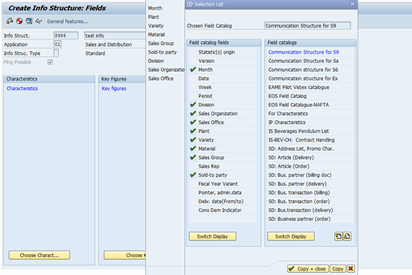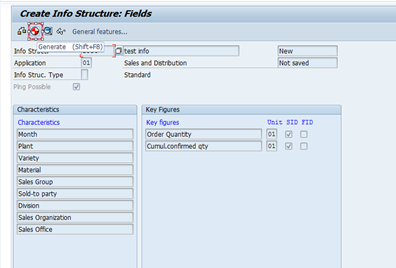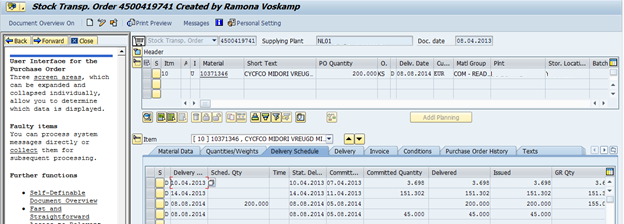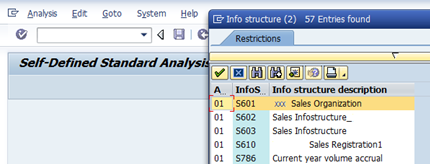
- SAP Community
- Products and Technology
- Enterprise Resource Planning
- ERP Blogs by Members
- Infostructures in SAP SD - Configuration and worki...
- Subscribe to RSS Feed
- Mark as New
- Mark as Read
- Bookmark
- Subscribe
- Printer Friendly Page
- Report Inappropriate Content
Article
Document Info structures in Sales and Distribution
Summary
This document captures the basic process flow of how an info-structure can be configured and used in sales and distribution.
Author: Ramya
Created On: 16th October, 2014
Author Bio: Ramya is a Consultant at Infosys & has over 2 years of professional work experience in SAP Sales and Distribution module. She is engineering graduate from Anna University & Post Graduate Diploma in Management from Birla Institute of Management Technology, Greater Noida.
Introduction
This document describes how Info-structures can be configured and maintained for the purpose of sales/forecasting in Sales and Distribution. Some orders have been created to see how the data is updated in the info structure. Also, the concept of conditions and requirement routines that place restrictions on the infostructure update has been captured.
What are Info Structures?
An information structure is a set of data that contains information (as a resultant of an operation) which is subsequently used for reporting and analysis.The standard SAP system has info structures from S001 to S500. Customizing of info structures can also be done. Number ranges for customizing info structure is from S500 to S999
Steps Involved in creating Info Structures:
The various steps involved in creation of an Info Structure are
- Creating Field Catalogue
- Creating Info structure
- Creating Update Groups
- CreatingUpdate Rules
- Set up LIS environment
- Set up statistical data for infostructure(this is to update old data)
Creating Field Catalogue
PATH : IMG->Logistrics general->Logistics Information System (LIS)-> Logistics Data Warehouse-> DataBasis->Field Catalog->Maintain self-defined field catalogs.Tcode : MC18
The Field Catalog is a set of fields that can be used in creating an info structure for determining the key figures and characteristics

Creating Info structure
PATH : IMG->Logistrics general->Logistics Information System (LIS)->Logistics Data Warehouse->Data Basis->Information Structures ->Maintain self-defined information structures . Tcode : MC21
PFB the sample of Info structure

The settings that needs to be maintained are
- Application that is used is selected as Sales and distribution
- Infostructure type : Standard.
Structure
An information structure comprises of
- Characteristics
- Key Figures
- Period unit (time reference)
Characteristics
Characteristics are the fields that are used in aggregation for the info structure (For example Plant, Material, Sales Organization etc...). The characteristics can be chosen by the Choose Characteristics option in the info structure. A pop up appears as shown below.

On clicking Copy + close, the chosen characteristics are displayed. Again copy must be clicked on. The characteristics will be reflected in the info structure.The number of Characteristics that can be assigned is limited to nine
Key Figures
Key figures are the fields that store the values that are updated during an operation and are used for analysis. For example Order quantity (Updated when an order is created for a particular material from a plant and sales organization), delivery quantity(delivery is created for the order) etc..The key figure that needs to be updated when the operation is carried out is chosen and copied. On copying, the data reflects in the info structure as shown below.

- Here the Unit refers to the Key of the unit in which the key figure is updated. For example, base unit or sales unit of measure, etc.
- SID indicator specifies whether or not the key figure values can be meaningfully cumulated.
- FID indicator is used to fix the values of this key figure in the planning table of Flexible Planning.
Period unit (time reference) – Explained under Step 4(Create Update Rules)
Every info structure has a period unit. Depending on the period unit, the key figure values are updated at regular intervals. The periods can be daily, weekly, monthly or any posting period of your choice. Generate Icon needs to be clicked in order to proceed.
Creating Update Groups
Update group must be created for the statistics updating. This can be done in the path below
PATH : IMG->Logistics-general->Logistics Information System (LIS)->Updating->Updating Definition->Generate Definition using Update Groups->Maintain Update Groups
A record is created with description. App refers to the application(same as in info structure)

Determination of the Update Group in Sales Order Header and Item level
The update group is determined at sales order header and item level through the settings made for the same.
PATH : IMG-Logistics General-Logistics Information System- Updating-Updating Definition- General Definition using Update Groups
Assign Update Group at Header Level
The update group is customized for the following combination
- Sales area (Sales Org, Distribution channel, Division)
- Customer statistics group
- Statistics group - sales document type
PFB a combination maintained for ZS610 update group.

If this condition is satisfied then the details will be updated in the sales order header. The sales order header is updated as per the combination maintained

Assign Update Group at Item Level
The update group is customized for the following combination
- Sales area (Sales Org, Distribution channel, Division)
- Customer statistics group
- Statistics group - sales document type
- Material statistics group
- Statistics group for the item category
PFB a combination maintained for ZS601 update group.

The sales order item level is updated as per the combination maintained

Creating Update Rules
The update rules determine how the key figures/characteristics in the info structure needs to be updated.
PATH : IMG->Logistrics general->Logistics Information System (LIS)->Updating->Updating Definition-> Specific definition using Update Rules->Maintain Update Rules.TCode : MC24.
Already existing update rule for Key Figures

- Event refers to an event for which the updating must happen. It could be order billing,delivery etc.. In this case, for order and cumulative order quantity, the Event is Sales Order and for delivery quantity, the event is delivery.
- Update type refers to the Type of updating used for key figure. For example if the value needs to be cumulative or overwritten every time a transaction happens. Cumulative updating is selected in this case
- Unit is the Key of the unit in which the key figure is updated. For example, base unit or sales unit of measure, etc.
- Source table and field refer to the table and field from which the info structure must be updated.
- Date field for period determination refer to the date that must be considered for aggregating the data according to the periodicity.
- Extended update rules comprises of
- Formula refers to the arithmetic formula for the statistics update.
- Req refers to the requirement for statistics updating. Here conditions for the updating of these fields can be controlled via a requirement routine. This requirement can be maintained as below.
- Program Name and Form Routine are used in case additional customization is required for the same. An user exit is created in such a case.
- Hierarchy is the Key that identifies the hierarchical level from the source document. During the update process, it determines the document levels from which information is required for the statistics.
Already existing update rule for Characteristics
- Form refers to the arithmetic formula for the statistics update.
- Hier refers to the Key that identifies the hierarchical level from the source document (document header item etc...).
Period Unit
After creating rules for all your key figures, go to Environment in the menu bar and choose activate updating.

Here the period split and updating for the info structures can be seen. On Double clicking the info structure, the period split and the updating (whether no updating is required or if the statistics update is made synchronously with the document update or if the statistics update is asynchronous) can be modified.

Set up LIS environment(Tcode : LBW0)
The info structure needs to be activated in the LIS environment through the transaction code LBW0

After this you can see the status of the info structure as active in MC23.
Set up statistical data for info structure(this is to update old data)
PATH : SBIW ->Setting for applications specific data source – logistics – Managing transfer information structure – setup of statistical data – applications specific setup of statistical data –perform statistical setup – sales. And distribution.
Choose activity, enter the info structure (S898), give name of the run, date of termination, time of termination, No. of tolerated faulty documents. Then execute.

After generating the following is updated in the LIS environment

Sample Order Process
Normal Order
Material 10076393 for the month of October is checked.Currently, there is no data for the material. Standard Order is created with Quantity 10 for the material. Delivery date in the order is 03.10.2014

The order and the cumulative order quantity gets updated for the month of October as shown below
![]()
Delivery created for the same

The same is getting reflected in the system under delivery quantity
![]()
Now the delivery is PGIed. The quantity now reflects in the Actual delivery quantity
![]()
Scenario: Order not updated in the info structure due to Requirement set for update rules in the info structure.
There is a requirement set in the update rules for the delivery quantity and actual delivery quantity

The condition is
Delivery Quantity – Requirement Routine 961
Quantity gets updated if Good Movement Status = A or B
If material div = '6A'
If material group = 'COM'
If delivery type = 'LF'
UPDATE.
If delivery type = 'ZNL' or 'NL'
If supplying plant = 'NL02' AND (receiving plant = 'NL03' OR 'NLYP')
UPDATE.
Actual Delivery Quantity– Requirement Routine 961
Quantity gets updated if Good Movement Status = C. All the other conditions are as mentioned above for delivery qty. Now a material with material division ‘6A’ is taken for the testing.

An existing STO is picked up and the quantity is updated from 155 to 200 (Difference 45).

Delivery with delivery type ‘NL’ is created

For this STO, the supplying plant is NL01. Hence as expected it is not getting reflected in the info structure.

Standard Report for customized Info structure
There is a standard report that can be used as an analysis tool for custom defined info structures.
PATH : Easy Access-Information Systems-Logistics-Sales and Distribution-Tools-User Defined analysis. Tcode : MCSI
All the info-structures under the category gets populated.

S601 is selected and executed for the following months.

The result of the analysis is as shown below

- SAP Managed Tags:
- SD (Sales and Distribution)
You must be a registered user to add a comment. If you've already registered, sign in. Otherwise, register and sign in.
-
"mm02"
1 -
A_PurchaseOrderItem additional fields
1 -
ABAP
1 -
ABAP Extensibility
1 -
ACCOSTRATE
1 -
ACDOCP
1 -
Adding your country in SPRO - Project Administration
1 -
Advance Return Management
1 -
AI and RPA in SAP Upgrades
1 -
Approval Workflows
1 -
Ariba
1 -
ARM
1 -
ASN
1 -
Asset Management
1 -
Associations in CDS Views
1 -
auditlog
1 -
Authorization
1 -
Availability date
1 -
Azure Center for SAP Solutions
1 -
AzureSentinel
2 -
Bank
1 -
BAPI_SALESORDER_CREATEFROMDAT2
1 -
BRF+
1 -
BRFPLUS
1 -
Bundled Cloud Services
1 -
business participation
1 -
Business Processes
1 -
CAPM
1 -
Carbon
1 -
Cental Finance
1 -
CFIN
1 -
CFIN Document Splitting
1 -
Cloud ALM
1 -
Cloud Integration
1 -
condition contract management
1 -
Connection - The default connection string cannot be used.
1 -
Custom Table Creation
1 -
Customer Screen in Production Order
1 -
Data Quality Management
1 -
Date required
1 -
Decisions
1 -
desafios4hana
1 -
Developing with SAP Integration Suite
1 -
Direct Outbound Delivery
1 -
DMOVE2S4
1 -
EAM
1 -
EDI
3 -
EDI 850
1 -
EDI 856
1 -
edocument
1 -
EHS Product Structure
1 -
Emergency Access Management
1 -
Energy
1 -
EPC
1 -
Financial Operations
1 -
Find
1 -
FINSSKF
1 -
Fiori
1 -
Flexible Workflow
1 -
Gas
1 -
Gen AI enabled SAP Upgrades
1 -
General
1 -
generate_xlsx_file
1 -
Getting Started
1 -
HomogeneousDMO
1 -
IDOC
2 -
Integration
1 -
Learning Content
2 -
LogicApps
2 -
low touchproject
1 -
Maintenance
1 -
management
1 -
Material creation
1 -
Material Management
1 -
MD04
1 -
MD61
1 -
methodology
1 -
Microsoft
2 -
MicrosoftSentinel
2 -
Migration
1 -
mm purchasing
1 -
MRP
1 -
MS Teams
2 -
MT940
1 -
Newcomer
1 -
Notifications
1 -
Oil
1 -
open connectors
1 -
Order Change Log
1 -
ORDERS
2 -
OSS Note 390635
1 -
outbound delivery
1 -
outsourcing
1 -
PCE
1 -
Permit to Work
1 -
PIR Consumption Mode
1 -
PIR's
1 -
PIRs
1 -
PIRs Consumption
1 -
PIRs Reduction
1 -
Plan Independent Requirement
1 -
Premium Plus
1 -
pricing
1 -
Primavera P6
1 -
Process Excellence
1 -
Process Management
1 -
Process Order Change Log
1 -
Process purchase requisitions
1 -
Product Information
1 -
Production Order Change Log
1 -
purchase order
1 -
Purchase requisition
1 -
Purchasing Lead Time
1 -
Redwood for SAP Job execution Setup
1 -
RISE with SAP
1 -
RisewithSAP
1 -
Rizing
1 -
S4 Cost Center Planning
1 -
S4 HANA
1 -
S4HANA
3 -
Sales and Distribution
1 -
Sales Commission
1 -
sales order
1 -
SAP
2 -
SAP Best Practices
1 -
SAP Build
1 -
SAP Build apps
1 -
SAP Cloud ALM
1 -
SAP Data Quality Management
1 -
SAP Maintenance resource scheduling
2 -
SAP Note 390635
1 -
SAP S4HANA
2 -
SAP S4HANA Cloud private edition
1 -
SAP Upgrade Automation
1 -
SAP WCM
1 -
SAP Work Clearance Management
1 -
Schedule Agreement
1 -
SDM
1 -
security
2 -
Settlement Management
1 -
soar
2 -
Sourcing and Procurement
1 -
SSIS
1 -
SU01
1 -
SUM2.0SP17
1 -
SUMDMO
1 -
Teams
2 -
User Administration
1 -
User Participation
1 -
Utilities
1 -
va01
1 -
vendor
1 -
vl01n
1 -
vl02n
1 -
WCM
1 -
X12 850
1 -
xlsx_file_abap
1 -
YTD|MTD|QTD in CDs views using Date Function
1
- « Previous
- Next »
- Quick Start guide for PLM system integration 3.0 Implementation/Installation in Enterprise Resource Planning Blogs by SAP
- SAP Table Creation, Maintenance, and Authorization in Enterprise Resource Planning Blogs by Members
- Asset Management in SAP S/4HANA Cloud Private Edition | 2023 FPS01 Release in Enterprise Resource Planning Blogs by SAP
- Asset posting not working on HANA - AFAB in Enterprise Resource Planning Q&A
- Review and Adapt Business Roles after a Major Upgrade in the SAP S/4HANA Cloud Public Edition in Enterprise Resource Planning Blogs by SAP
| User | Count |
|---|---|
| 5 | |
| 2 | |
| 2 | |
| 2 | |
| 2 | |
| 2 | |
| 1 | |
| 1 | |
| 1 | |
| 1 |